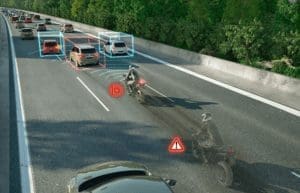Continental is launching a new emergency brake assist system for motorcycles, as part of its range of advanced rider assistance systems.
The big news for Continentals new fifth-generation radar sensors is its enhanced object detection, which works to inform its high-performance emergency brake assist system. It’s different from the way the technology is used in cars though. In a car, an emergency brake assist automatically performs emergency braking with maximum braking force when a collision is imminent, but the motorcycle system works in a much more measured way. The bike system is designed to help the rider, rather than to take control.
Emergency brake assist uses a radar sensor to monitor the area in front of the motorcycle – and if there is a risk of a collision, the rider is alerted by a visual, audible or physical warning. Then a low amount of initial braking pressure is applied, helping the rider with the active braking operation. And if the rider does not react to the warning, the emergency brake assist automatically builds up braking force – as long as the rider has both hands on the handlebars.
Interestingly, according to Continental accident research, a large number of rear-end collisions could be prevented with an emergency brake assist – in the not too distant future.
Christian Pfeiffer, ARASTM project manager for the area of 2-Wheelers and Powersports at Continental said: “Unlike in cars, motorcyclists are very much exposed to environmental factors such as the wind, weather and vibrations, and this makes riding a very challenging task. As a result, motorcyclists more frequently find themselves in situations in which it is difficult to estimate the speeds of other road users.”
“Emergency brake assist for motorcycles is therefore primarily indicative in nature. It draws the rider’s attention to critical situations and makes them more readily understandable. As is the case with cars, the system reduces speed here as well. However, the goal is to initiate a process that the rider can then take control of. This shortens the response time, which in turn can reduce stopping distance considerably.”



